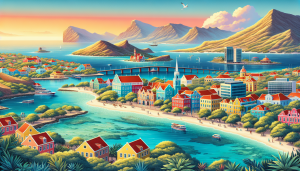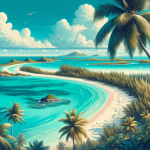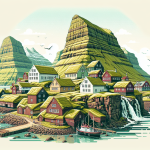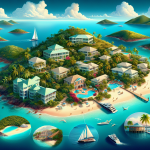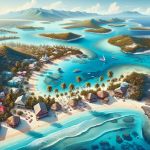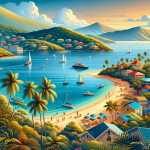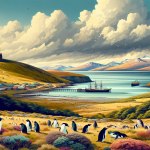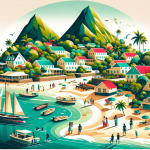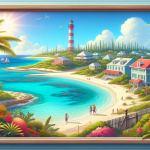Discovering the Enchanting Island of Curaçao: A Caribbean Paradise
Nestled in the heart of the Caribbean Sea, Curaçao is a hidden gem known for its stunning beaches, vibrant culture, and rich history. As part of the ABC islands (Aruba, Bonaire, and Curaçao), this small but captivating island offers an abundance of activities, picturesque landscapes, and a warm, welcoming atmosphere that makes it a must-visit destination. In this comprehensive guide, we’ll delve into the highlights of Curaçao, from its pristine beaches and diverse marine life to its charming capital city, Willemstad, and its fascinating cultural heritage. Whether you’re an adventure seeker, a history buff, or simply looking for a relaxing getaway, Curaçao has something for everyone. Join us as we explore the wonders of this Caribbean paradise.
Pristine Beaches and Crystal Clear Waters
Playa Kenepa Grandi
One of the most famous beaches in Curaçao is Playa Kenepa Grandi, also known as Grote Knip. This stunning beach is renowned for its turquoise waters, powdery white sand, and breathtaking views. Visitors can indulge in snorkeling, swimming, or simply soaking up the sun while enjoying the tranquil surroundings.
Cas Abao Beach
Cas Abao Beach is another must-visit spot for beach lovers. This idyllic beach offers a perfect blend of natural beauty and modern amenities, including beach bars, sun loungers, and water sports facilities. The coral reefs just offshore make it an excellent location for snorkeling and diving, where you can encounter a variety of colorful marine life.
Playa Lagun
For those seeking a more secluded and intimate beach experience, Playa Lagun is the ideal choice. Nestled between cliffs, this small beach is a popular spot for diving and snorkeling. The calm, clear waters provide excellent visibility, allowing you to explore the vibrant underwater world teeming with tropical fish and sea turtles.
Vibrant Capital: Willemstad
Punda and Otrobanda
Willemstad, the capital city of Curaçao, is a UNESCO World Heritage site known for its colorful colonial architecture and historic significance. The city is divided into two main districts: Punda and Otrobanda, connected by the iconic Queen Emma Bridge. Punda is famous for its pastel-colored buildings, charming streets, and bustling markets, while Otrobanda offers a more authentic local experience with its narrow alleys and vibrant street art.
Queen Emma Bridge
The Queen Emma Bridge, also known as the “Swinging Old Lady,” is a floating pontoon bridge that connects Punda and Otrobanda. This unique bridge opens and closes to allow ships to pass through the harbor, providing a fascinating sight for visitors. Walking across the bridge offers stunning views of the Willemstad waterfront and is a quintessential Curaçao experience.
Mikve Israel-Emanuel Synagogue
A visit to Willemstad wouldn’t be complete without exploring the Mikve Israel-Emanuel Synagogue, the oldest synagogue in continuous use in the Western Hemisphere. Established in 1732, this synagogue is a testament to the island’s rich Jewish heritage. The sand-covered floors and historic artifacts provide a glimpse into the island’s past and its diverse cultural tapestry.
Diving and Snorkeling Adventures
Tugboat Wreck
Curaçao is a diver’s paradise, offering numerous dive sites that cater to all levels of experience. One of the most popular dive sites is the Tugboat Wreck, located in the Caracas Bay. This sunken tugboat is covered in coral and attracts a variety of marine life, making it an exciting spot for both divers and snorkelers.
Mushroom Forest
Mushroom Forest is another iconic dive site in Curaçao, named for its unique mushroom-shaped coral formations. This underwater forest is home to an array of marine species, including parrotfish, moray eels, and sea turtles. The combination of stunning coral formations and diverse marine life makes it a must-visit for underwater enthusiasts.
Blue Room Cave
For a truly unique underwater experience, head to the Blue Room Cave. This hidden gem can be accessed by boat or a short swim from the shore. The cave’s entrance is submerged, requiring divers to swim through a narrow passage to reach the cavern. Once inside, you’ll be greeted by an ethereal blue glow created by the sunlight filtering through the water. The Blue Room Cave is a magical spot for snorkeling and free diving, offering a surreal and unforgettable experience.
Cultural Heritage and Historic Sites
Kura Hulanda Museum
The Kura Hulanda Museum, located in Otrobanda, provides a comprehensive look at Curaçao’s complex history, particularly its role in the transatlantic slave trade. The museum’s extensive collection includes artifacts, exhibits, and multimedia presentations that shed light on the island’s African heritage and the impact of slavery on its culture.
Landhuis Chobolobo
For a taste of Curaçao’s famous liqueur, a visit to Landhuis Chobolobo is a must. This historic plantation house is home to the Curaçao Liqueur Distillery, where the iconic Blue Curaçao liqueur is produced. Visitors can take a guided tour to learn about the distillation process, sample different flavors, and explore the beautiful grounds of the estate.
Fort Amsterdam
Fort Amsterdam, located in the heart of Willemstad, is a historic fortress that dates back to the 17th century. Originally built to protect the island from invaders, the fort now houses government offices and the Fort Church, one of the oldest Protestant churches in the Caribbean. The fort’s strategic location offers panoramic views of the harbor and the city, making it a great spot for history enthusiasts and photographers.
Outdoor Activities and Natural Wonders
Christoffel National Park
Christoffel National Park is the largest national park in Curaçao, offering a diverse range of outdoor activities and natural attractions. Visitors can hike to the summit of Christoffel Mountain, the highest point on the island, for breathtaking views of the landscape. The park is also home to a variety of wildlife, including white-tailed deer, iguanas, and several species of birds.
Shete Boka National Park
Located on the rugged northern coast of Curaçao, Shete Boka National Park is known for its dramatic coastline and powerful waves crashing against the rocky shores. The park features several boka (inlets), where visitors can witness the raw power of the ocean. Boka Pistol is particularly famous for its explosive waves that create a cannon-like effect, while Boka Tabla offers a serene cave that can be explored on foot.
Hato Caves
The Hato Caves, located just outside Willemstad, are a fascinating natural wonder that offers a glimpse into the island’s geological history. Formed over millions of years, these limestone caves feature stalactites, stalagmites, and underground pools. Guided tours take visitors through the cave’s impressive chambers, where they can learn about the cave’s formation, ancient Amerindian petroglyphs, and the legend of the Hato Caves.
Culinary Delights and Local Flavors
Plasa Bieu
Plasa Bieu, also known as the Old Market, is a popular spot in Willemstad for experiencing authentic Curaçaoan cuisine. This bustling food hall offers a variety of local dishes, including stobá (stew), kabritu (goat), and fresh seafood. The communal dining setup allows visitors to mingle with locals and savor the flavors of the island.
Jaanchie’s Restaurant
For a truly unique dining experience, head to Jaanchie’s Restaurant in the village of Westpunt. This family-run establishment has been serving traditional Curaçaoan dishes for over 60 years. The menu is recited by the owner, Jaanchie, who provides a personal touch and insight into the island’s culinary traditions. Don’t miss the opportunity to try the iguana stew, a local delicacy that is said to have medicinal properties.
Blue Curaçao Liqueur
No visit to Curaçao would be complete without sampling the island’s famous Blue Curaçao liqueur. This vibrant blue liqueur is made from the dried peel of the Laraha citrus fruit, a bitter orange native to the island. It is often used in cocktails and can be enjoyed in various flavors, including orange, chocolate, and coffee. Many bars and restaurants on the island offer creative cocktails featuring Blue Curaçao, providing a refreshing way to cool down and enjoy the island’s tropical ambiance.
Festivals and Events
Carnival
Curaçao’s Carnival is one of the most vibrant and anticipated events on the island. This annual celebration takes place in the weeks leading up to Lent and features colorful parades, music, dancing, and elaborate costumes. The Grand Parade, known as the Marcha di Despedida, is the highlight of the Carnival season, attracting thousands of spectators who come to witness the spectacular floats and performances.
Curaçao North Sea Jazz Festival
The Curaçao North Sea Jazz Festival is a major cultural event that draws music lovers from around the world. Held in September, this three-day festival features performances by internationally renowned artists across various genres, including jazz, blues, soul, and Latin music. The festival takes place at the World Trade Center in Piscadera Bay, offering a stunning backdrop for an unforgettable musical experience.
Seú Harvest Festival
The Seú Harvest Festival is a traditional celebration that takes place in the spring, marking the end of the harvest season. This cultural event features parades, music, dancing, and traditional costumes, showcasing the island’s agricultural heritage and local customs. The festival provides a unique opportunity to experience the rich cultural traditions of Curaçao and connect with the local community.
Sustainable Tourism and Conservation Efforts
Coral Restoration Foundation
Curaçao is committed to preserving its natural beauty and marine ecosystems through various conservation efforts. The Coral Restoration Foundation is one such initiative, focusing on the restoration of coral reefs around the island. Visitors can participate in coral planting activities and learn about the importance of reef conservation through guided tours and educational programs.
Sea Turtle Conservation
Curaçao is home to several species of sea turtles, including the hawksbill, green, and loggerhead turtles. The island’s conservation programs aim to protect these endangered species through nesting site monitoring, beach clean-ups, and public awareness campaigns. Visitors can support these efforts by participating in turtle-watching tours and following guidelines to minimize their impact on the turtles’ habitats.
Sustainable Accommodations
Many hotels and resorts in Curaçao are adopting sustainable practices to reduce their environmental footprint and promote responsible tourism. These eco-friendly accommodations implement measures such as energy-efficient systems, waste reduction programs, and the use of locally sourced products. By choosing sustainable accommodations, visitors can contribute to the island’s conservation efforts while enjoying a comfortable and eco-conscious stay.
Practical Information for Visitors
Getting There
Curaçao is easily accessible by air, with direct flights available from major cities in the United States, Europe, and South America. The island’s main airport, Hato International Airport, is located just a short drive from Willemstad. Several airlines offer regular flights to Curaçao, making it a convenient destination for travelers.
Getting Around
Renting a car is the most convenient way to explore Curaçao, as it allows you to access the island’s various attractions at your own pace. Public transportation, including buses and minibusses, is also available, although it may be less reliable and limited in coverage. Taxis are another option, particularly for short trips within Willemstad.
Language and Currency
The official languages of Curaçao are Dutch, Papiamentu, and English, with most locals also speaking Spanish. English is widely spoken, making it easy for visitors to communicate and navigate the island. The currency used in Curaçao is the Netherlands Antillean guilder (ANG), although US dollars are also widely accepted. ATMs are available throughout the island, and major credit cards are accepted at most establishments.
Safety and Health
Curaçao is generally considered a safe destination for travelers, with a low crime rate and a friendly local population. However, it is always advisable to take standard precautions, such as avoiding isolated areas at night and keeping an eye on your belongings. The island has a well-developed healthcare system, with several hospitals and clinics available to provide medical assistance if needed. It is recommended to have travel insurance that covers medical expenses during your stay.
Best Time to Visit
Curaçao enjoys a tropical climate with warm temperatures year-round, making it an ideal destination for a beach vacation at any time. The island’s dry season, from January to September, is the most popular time to visit, with plenty of sunshine and minimal rainfall. The wet season, from October to December, brings occasional showers, but these are typically short-lived and do not significantly impact travel plans. The island is located outside the hurricane belt, so visitors can enjoy a worry-free vacation even during the Atlantic hurricane season.
Conclusion
Curaçao is a captivating destination that offers a perfect blend of natural beauty, cultural richness, and recreational activities. From its pristine beaches and vibrant marine life to its historic sites and lively festivals, the island has something for everyone. Whether you’re seeking adventure, relaxation, or a cultural experience, Curaçao promises an unforgettable Caribbean getaway. By embracing sustainable tourism practices, visitors can help preserve the island’s unique charm and ensure that future generations can continue to enjoy its wonders. So pack your bags, and get ready to discover the enchanting island of Curaçao!
